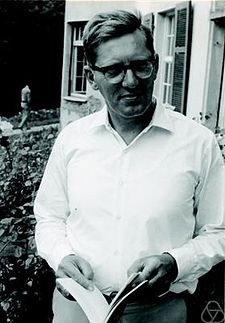Nicolaas Govert de Bruijn
- Nicolaas Govert de Bruijn
-
Nicolaas Govert (Dick) de Bruijn (born 9 July 1918) is a Dutch mathematician, affiliated as professor emeritus with the Eindhoven University of Technology. He received his Ph.D. in 1943 from Vrije Universiteit Amsterdam.[1]
De Bruijn covered many areas of mathematics. He is especially noted for the invention of the De Bruijn sequence. He is also partly responsible for the De Bruijn–Newman constant, the De Bruijn–Erdős theorem (in both incidence geometry and graph theory) and the BEST theorem. He wrote one of the standard books in advanced asymptotic analysis (De Bruijn, 1958). De Bruijn also worked on the theory of Penrose tilings. In the late sixties, he designed the Automath language for representing mathematical proofs, so that they could be verified automatically (see automated theorem checking). Lately, he has been working on models for the human brain.
Publications
- de Bruijn, Asymptotic Methods in Analysis, North-Holland, Amsterdam, 1958.
See also
References
External links
| Persondata |
| Name |
Bruijn, Nicolaas Govert de |
| Alternative names |
|
| Short description |
|
| Date of birth |
9 July 1918 |
| Place of birth |
The Hague |
| Date of death |
|
| Place of death |
|
Categories:
- 1918 births
- Living people
- 20th-century mathematicians
- Combinatorialists
- Dutch mathematicians
- Eindhoven University of Technology faculty
- Delft University of Technology faculty
- Graph theorists
- People from The Hague
Wikimedia Foundation.
2010.
Look at other dictionaries:
Nicolaas Govert De Bruijn — Pour les articles homonymes, voir De Bruijn. Nicolaas Govert de Bruijn (9 juillet 1918 ) est un mathématicien hollandais affilié comme professeur émérite de l Université Technique d Eindhoven. Il s est intéressé à plusieurs branches des… … Wikipédia en Français
Nicolaas govert de bruijn — Pour les articles homonymes, voir De Bruijn. Nicolaas Govert de Bruijn (9 juillet 1918 ) est un mathématicien hollandais affilié comme professeur émérite de l Université Technique d Eindhoven. Il s est intéressé à plusieurs branches des… … Wikipédia en Français
Nicolaas Govert de Bruijn — (* 9. Juli 1918, Den Haag) ist ein niederländischer Mathematiker, der sich vor allem mit Analysis, Zahlentheorie, Kombinatorik und Informatik (diskreter Mathematik) beschäftigt. De Bruijn in den 1960er Jahren … Deutsch Wikipedia
Nicolaas Govert de Bruijn — Pour les articles homonymes, voir De Bruijn. De Bruijn à Oberwolfach, dans les années 1960 Nicolaas Govert de Bruijn (né le 9 juillet 1918) est un mathématicien … Wikipédia en Français
Bruijn — Nicolaas Govert de Bruijn Pour les articles homonymes, voir De Bruijn. Nicolaas Govert de Bruijn (9 juillet 1918 ) est un mathématicien hollandais affilié comme professeur émérite de l Université Technique d Eindhoven. Il s est intéressé à… … Wikipédia en Français
Nicolaas — ist ein männlicher Vorname. Inhaltsverzeichnis 1 Herkunft und Bedeutung 2 Bekannte Namensträger 2.1 Vorname 2.2 Zwischenname … Deutsch Wikipedia
Bruijn — may refer to;* Chantal de Bruijn Dutch field hockey player. * Cornelis de Bruijn (1652 1727) a Dutch artist and traveler. * Inge de Bruijn a former Dutch swimmer. * Nicolaas Govert de Bruijn a Dutch mathematician. * Pi de Bruijn a Dutch… … Wikipedia
Bruijn — ist der Name folgender Personen: Adrianus Cornelis de Bruijn (1896–1980), niederländischer Gewerkschaftsführer Chantal de Bruijn (* 1976), niederländische Hockeyspielerin Cornelis de Bruijn (1652–1727), niederländischer Künstler und Reisender… … Deutsch Wikipedia
N. G. de Bruijn — Nicolaas Govert de Bruijn (* 9. Juli 1918, Den Haag) ist ein niederländischer Mathematiker, der sich vor allem mit Analysis, Zahlentheorie, Kombinatorik und Informatik (diskreter Mathematik) beschäftigt. Inhaltsverzeichnis 1 Leben und Wirken 2… … Deutsch Wikipedia
De Bruijn — Bruijn ist der Name folgender Personen: Adrianus Cornelis de Bruijn (1896–1980), niederländischer Gewerkschaftsführer Chantal de Bruijn (* 1976), niederländische Hockeyspielerin Cornelis de Bruijn (1652–1727), niederländischer Künstler und… … Deutsch Wikipedia

